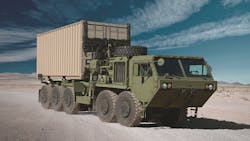Army researchers developing technology to enable unmanned ground vehicles to take-on off-road navigation
WARREN, Mich. – While the private sector struggles to perfect self-driving cars for well-mapped and maintained roads, the U.S. Army Ground Vehicle Systems Center (GVSC) in Warren, Mich., has developed a standard set of software and sensors that can turn wheeled and tracked vehicles into off-road unmanned ground vehicles (UGVs). Breaking Defense reports. Continue reading original article
The Military & Aerospace Electronics take:
2 Dec. 2019 -- Self-driving civilian vehicles can rely on marked lanes, paving, curbs, and access to GPS and mapping applications. One of the big attractions of 5G networks is how their much greater bandwidth might make self-driving cars safe on the open road.
By contrast, an unmanned military vehicle might not even have a map to rely on. GVSC has developed navigation software where the vehicle starts with no map data, slowly explores the area, and builds its own map. This mode isn’t enabled on all vehicles, but it’s shown promise in experiments.
The GVSC has even done experiments where one unmanned vehicle explores the area and shares its map data with others. Still, there’s long term potential to swarm expendable scout robots in an urban area to map the roads, alleys, and underground tunnels, before human troops enter these potential ambush zones.
Related: The new world of counter-drone technology
Related: General Dynamics to provide Army with military vehicles and vetronics for ground mobility
John Keller, chief editor
Military & Aerospace Electronics

